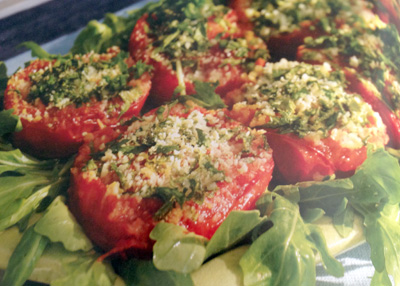
Summer. Provence. Two words that are eternally linked together. One can’t think of this southern French locale without immediately imaging yourself overlooking the sea from a seat on a patio with a glass of rosé in your hand. Well, maybe that’s just me. Being a wine lover, Provence is one of those destinations on my bucket list. A place I plan to spend many lovely, languid, lazy days doing nothing but eating and drinking and watching the world go by. It’s not a wine region that’s garnered much respect over the years, since it’s mostly famous for crafting all shades of pink, which until this decade didn’t appear to be to something that most serious wine drinkers gave much thought to. Rosé was something you drank on your way to “better” more serious wine.
Well, as Francois Millo and Viktorija Todorovska show in their new book, Provence Food and Wine: The Art of Living rosé from this region has been serious all along. Francois has actually written THE French textbook about rose wines, along with several other wine tomes, and is from Provence. (Lucky devil.) Viktorija is a cookbook author in love with the Mediterranean lifestyle (she’s also written books about Puglia and Sardinia) and marries her love of traditional recipes with his knowledge of the region and his amazing eye (he’s also the book’s photographer). Together they bring the joie de vivre of this region right to your fingertips, capturing it’s allure with simplicity and heart.
Wine has been made in Provence since Greek sailors landed in Marseille in 600 BCE and brought their grapevines with them. That’s a long time to get it right. In 1935, the region - known as Cotes de Provence - was awarded one of the first AOC designations - a production zone that is delineated not only by historical significance, but by methodology and grape variety as one of superior quality that showcases terroir that is unique. While those from the New World, sometimes pooh-pooh, the French appellation laws, by having to confirm to “the rules” of their appellation there is some guarantee of quality involved. Sometimes tradition is a good thing. Certainly decades of experience at a craft have to count for something.
 Frankly before reading this book, I had no idea there were NINE AOCs in the region - I could have named four of the nine - or FOUR sub-AOCs (even more distinct characteristics). Why should most of us care? Well, because that’s where the fun begins, the exploration of what makes these places unique. Do you prefer the minerality of the rosés from the Cotes de Provence Sainte-Victoire, the more earthy notes of the mourvedre-based Bandols, the bright aromatics of the Frejus?
Frankly before reading this book, I had no idea there were NINE AOCs in the region - I could have named four of the nine - or FOUR sub-AOCs (even more distinct characteristics). Why should most of us care? Well, because that’s where the fun begins, the exploration of what makes these places unique. Do you prefer the minerality of the rosés from the Cotes de Provence Sainte-Victoire, the more earthy notes of the mourvedre-based Bandols, the bright aromatics of the Frejus?
There are over 300 wineries making predominantly rosé, but whites and reds are also produced though not as readily available outside the region. The book explains each of these AOCs and what makes them special without being overly clinical, which is great for both beginners and oenophiles like. There is clearly more to this wine region than most wine drinkers give it credit for and I gained a new respect reading through this section.
The heart of the book, however, is in the lifestyle section, broken down info four chapters featuring the cuisine and specialties of each major area: Aix-en-Provence, Marseille, La Cote Varoise and the Riviera. As one can imagine most of the recipes feature not only seasonal fruits and vegetables, but a lot of seafood as well. While most are prepared with limited ingredients the flavors are old-school, fresh as it comes, and complex, all derived to pair perfectly with the local wines. Items like Tomatoes Provencal or Bouillabaisse or Octopus Stew with Rose - speak clearly of place and eating local, long before it was the latest buzz word. It’s about friendship and entertaining and being out in the sunshine, enjoying the world at one’s most basic happy place…with a glass in hand and a full belly. I may not get to Provence for a few years yet, but now, at least, I can visit whenever I need a little extra boost of summer living done well.
Tomatoes Provencal
 Yield: 4 servings
Yield: 4 servings
4 small to medium ripe tomatoes, halved and stems removed
1 teaspoon granulated sugar
2 tablespoons extra virgin olive oil
1/2 cup chopped fresh parsley
4 cloves garlic, minced
2 tablespoons fresh breadcrumbs
1/2 teaspoon sea salt, plus more to taste
Freshly ground black pepper, to taste
1. Lightly dust the cut sides of the tomatoes with the sugar.
2. In a large sauté pan, warm the oil over medium heat. Add the tomatoes, cut side down and cook for 5 to 6 minutes, until they caramelize.
3. In a small mixing bowl, combine the parsley and garlic.
4. Flip the tomatoes and distribute the parsley and garlic mixture evenly onto them, pressing down so the mixture adheres to the tomato. Sprinkle with the 1/2 teaspoon of salt and black pepper. Distribute the breadcrumbs evenly among the tomatoes.
5. Reduce the heat to low, cover, and cook for 5 to 6 minutes, until the tomatoes are soft and fully cooked through. Remove from the heat. Adjust the seasoning to taste.
6. Transfer the tomatoes to a serving dish and serve warm.
Recipe courtesy of Provence Food and Wine: The Art of Living. Copyright 2014 by Vikrorija Todorovka and Francois Millo.

